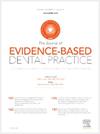THE UTILITY OF DEEP LEARNING MODEL IN CLINICAL TREATMENT DECISION-MAKING OF MANDIBULAR THIRD MOLAR: A SYSTEMATIC REVIEW AND META-ANALYSIS
IF 4
4区 医学
Q1 DENTISTRY, ORAL SURGERY & MEDICINE
引用次数: 0
Abstract
Objectives
To evaluate the effectiveness of deep learning (DL) in medical imaging for improving clinical procedures related to the mandibular third molar (MM3).
Methods
Our systematic search included databases such as PubMed, EMBASE, Web of Science, and the Cochrane Library, up to April 10, 2024. The Quality Assessment of Diagnostic Accuracy Studies-2 (QUADAS-2) tool was used to assess the potential bias and clinical relevance of the studies. To examine the interaction between MM3 and the inferior alveolar nerve (IAN), we conducted a meta-analysis using a bivariate mixed-effects model to compare the performance of DL methods with that of human experts.
Results
In this comprehensive review, a total of 33 scholarly works involving 45,029 imaging instances were analyzed. Among these, 15 studies specifically focused on evaluating the performance of DL methods in identifying the spatial relationship between MM3 and IAN. The aggregated results showed that DL achieved a diagnostic sensitivity of 0.89 (95% CI, 0.85-0.93) and a specificity of 0.88 (95% CI, 0.80-0.93). In parallel, a comparative meta-analysis that included assessments from 16 clinical experts revealed slightly lower sensitivity (0.76; 95% CI, 0.65-0.85) and specificity (0.86; 95% CI, 0.70-0.94). Additionally, the review explored the utility of DL in predictive modeling of MM3 eruption, assessing the complexity of extraction procedures, and identifying MM3 characteristics. The 18 studies in this area demonstrated diagnostic sensitivity ranging from 0.80 to 0.94 and specificity from 0.75 to 0.97, collectively highlighting the strong prognostic capabilities of DL in these clinical applications.
Conclusions
DL has demonstrated remarkable efficacy, especially in precisely identifying the anatomical connections between MM3 and IAN. Moreover, DL excels in identifying, categorizing, and assessing the complexity associated with MM3 extractions. This study confirms the substantial value of DL, particularly when utilized through image-based methods, in improving clinical management strategies for MM3. The creation of intelligent diagnostic tools using oral panoramic radiographs (OPGs) is strongly encouraged to assist physicians, especially those with limited clinical experience, in enhancing their diagnostic accuracy. These advancements in DL applications are expected to significantly improve the accuracy and efficiency of clinical diagnoses in oral and maxillofacial surgeries.
深度学习模型在下颌第三磨牙临床治疗决策中的应用:系统回顾和荟萃分析
目的评价深度学习(DL)在医学影像学中改进下颌第三磨牙(MM3)临床操作的有效性。方法系统检索截至2024年4月10日的PubMed、EMBASE、Web of Science、Cochrane Library等数据库。使用诊断准确性研究质量评估-2 (QUADAS-2)工具评估研究的潜在偏倚和临床相关性。为了研究MM3与下肺泡神经(IAN)之间的相互作用,我们使用双变量混合效应模型进行了荟萃分析,以比较DL方法与人类专家的性能。结果本综述共分析了33篇学术论文,涉及45,029例影像学病例。其中,有15项研究专门评估了DL方法在识别MM3和IAN之间空间关系方面的性能。综合结果显示,DL的诊断敏感性为0.89 (95% CI, 0.85-0.93),特异性为0.88 (95% CI, 0.80-0.93)。与此同时,一项包括16位临床专家评估的比较荟萃分析显示,敏感性(0.76;95% CI, 0.65-0.85)和特异性(0.86,95% CI, 0.70-0.94)略低。此外,本文还探讨了DL在MM3喷发预测建模中的应用,评估提取程序的复杂性,并确定MM3特征。该领域的18项研究表明,DL的诊断敏感性为0.80 ~ 0.94,特异性为0.75 ~ 0.97,共同强调了DL在这些临床应用中的强大预后能力。结论sdl具有显著的疗效,特别是在精确识别MM3与IAN之间的解剖联系方面。此外,DL在识别、分类和评估与MM3提取相关的复杂性方面表现出色。本研究证实了DL在改善MM3临床管理策略方面的巨大价值,特别是通过基于图像的方法加以利用时。强烈鼓励使用口腔全景x线片(OPGs)创建智能诊断工具,以帮助医生,特别是那些临床经验有限的医生,提高他们的诊断准确性。DL应用的这些进步有望显著提高口腔颌面外科临床诊断的准确性和效率。
本文章由计算机程序翻译,如有差异,请以英文原文为准。
求助全文
约1分钟内获得全文
求助全文
来源期刊

Journal of Evidence-Based Dental Practice
DENTISTRY, ORAL SURGERY & MEDICINE-
CiteScore
6.00
自引率
16.70%
发文量
105
审稿时长
28 days
期刊介绍:
The Journal of Evidence-Based Dental Practice presents timely original articles, as well as reviews of articles on the results and outcomes of clinical procedures and treatment. The Journal advocates the use or rejection of a procedure based on solid, clinical evidence found in literature. The Journal''s dynamic operating principles are explicitness in process and objectives, publication of the highest-quality reviews and original articles, and an emphasis on objectivity.
 求助内容:
求助内容: 应助结果提醒方式:
应助结果提醒方式:


